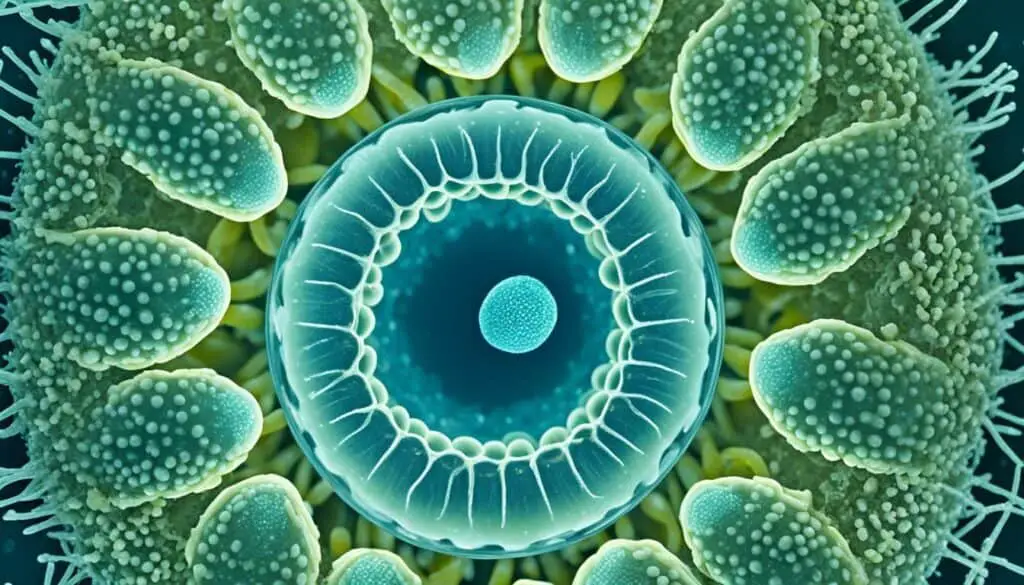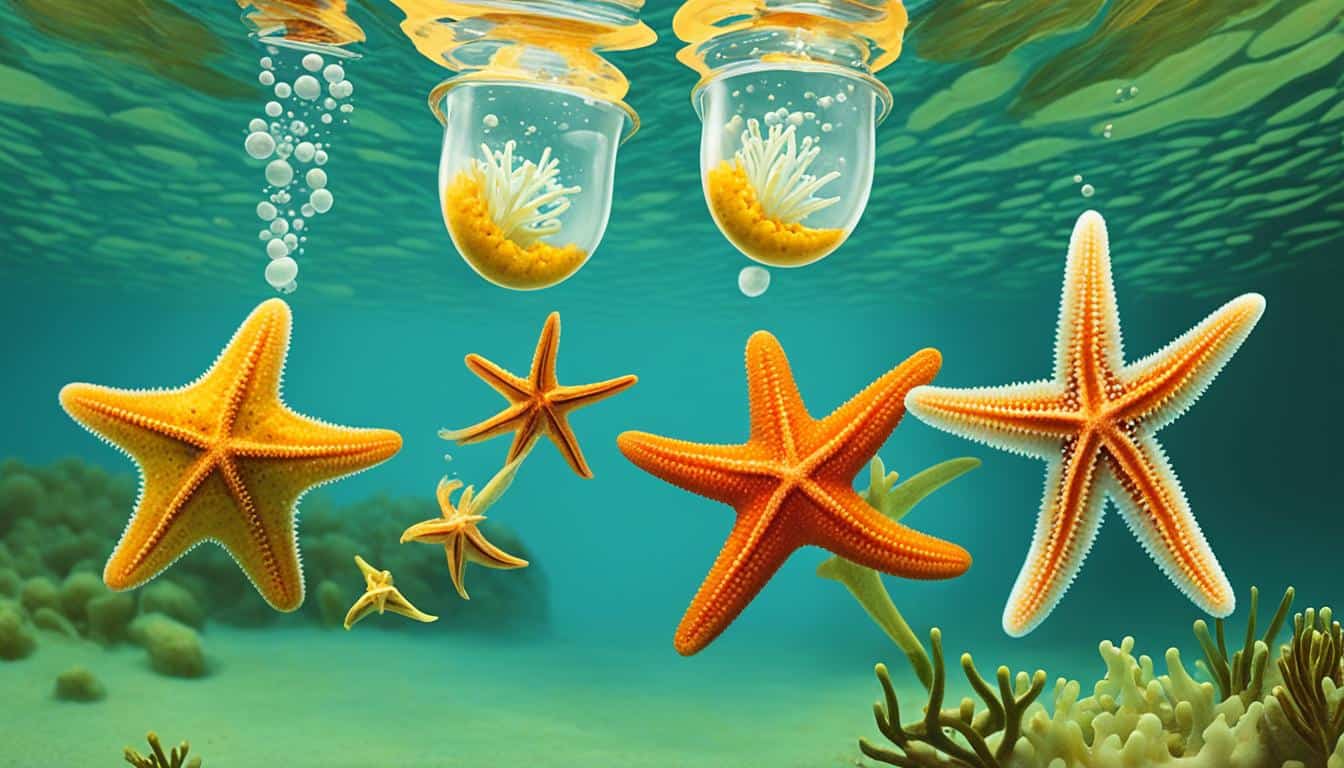Starfish, known scientifically as Asteroidea, are key to marine ecosystems. You might ask, how do starfish reproduce? With about 2,000 species across different habitats, from colorful coral reefs to deep ocean floors, their reproduction is quite adaptable. They can reproduce both sexually and asexually, helping them survive in many places. Learning about starfish reproduction helps us understand their life cycle and how they breed, which is important for ocean health.
Understanding Starfish Reproduction Process
The starfish reproduction process is quite interesting. It shows how these sea creatures spread their kind. They use two main ways: sexual and asexual reproduction. Each way has its own special traits that help the starfish survive.
Types of Reproduction in Starfish
Learning about starfish reproduction helps us understand marine life better. It shows how life thrives in the ocean. Starfish reproduce in two main ways:
- Sexual Reproduction: This involves male and female starfish. They fertilize outside the body.
- Asexual Reproduction: This includes breaking apart and growing new starfish from parts.
Sexual vs. Asexual Reproduction
Looking at sexual and asexual reproduction shows how starfish adapt. In sexual reproduction, starfish release sperm and eggs into the sea. This leads to larvae that grow into new starfish.
Asexual reproduction has two main ways:
- Fragmentation: A starfish arm part can grow into a new starfish.
- Fission: The starfish splits into two, each half growing back into a full starfish.
| Reproduction Type | Process | Outcome |
|---|---|---|
| Sexual | External fertilization of eggs and sperm in water | Free-swimming larvae, leading to adult starfish |
| Asexual | Fragmentation and fission | New individual grown from a pre-existing part |
How do starfish reproduce?
Starfish have unique ways of reproducing that mainly involve external fertilization. This means both males and females release their gametes into the water at the same time. This happens during spawning events, often triggered by certain environmental changes.
Fertilization Methods in Starfish
The way starfish fertilize is key to their reproductive success. They use external fertilization, which means sperm and eggs meet outside the body. This method increases the chances of successful fertilization in the vast ocean. Different starfish species have evolved to improve their spawning conditions.
External Fertilization Explained
External fertilization is vital for starfish reproduction. After gametes are released, fertilized eggs become embryos. These embryos are a crucial food source for many marine creatures. Some starfish time their spawning with the moon phases or water temperature, showing how important environment cues are for reproduction.
Starfish Breeding Behavior and Habitats
Starfish have interesting ways of breeding that show how well they adapt to different places. Learning about starfish breeding behavior helps us understand how they reproduce and survive. They pick certain places that help them have successful babies.
Preferred Breeding Environments
Starfish live in many preferred breeding environments. Important places include:
- Coral reefs, which give them shelter and lots of food.
- Kelp forests, where they stay safe during breeding time.
- Sandy areas, where they can hide and find food.
Things like water temperature and salt levels affect their breeding. In mating seasons, you might see lots of starfish together. They do this to increase their chances of making babies. These places are key for mating and helping baby starfish survive.
Starfish Life Cycle: From Larvae to Adult
The starfish life cycle starts with fertilization and goes through many changes. These changes show how they grow from larvae to adults. Each stage is important for their survival and how they affect the ocean.
The Stages of Starfish Development
The starfish journey starts with fertilized eggs. These eggs hatch into free-swimming larvae that join the ocean’s plankton. As they move through the water, they change a lot.
Eventually, they settle on the ocean floor as young starfish. This is a key moment in their life cycle.
Importance of Metamorphosis in Starfish
Metamorphosis is a key part of a starfish’s development. When young starfish change from larvae, they face new challenges. This big change helps them grow special features for hunting and surviving.
It also changes what they need to eat, helping them use their environment better.

Reproductive Strategies of Starfish
Brooding is key for many starfish, letting females care for their young early on. This helps the young starfish survive better, which is vital for their life cycle. Brood variations show how different starfish adapt to their surroundings.
Brooding and its Variations
Starfish have unique brooding ways, showing their special places and conditions. Here’s a table that highlights some brood variations and their traits:
| Starfish Species | Brood Variation | Protection Method | Location of Brooding |
|---|---|---|---|
| Patiria miniata | Encapsulation of Eggs | Specialized baskets | Shallow waters |
| Leptasterias hexactis | Direct Attachment | Physical connection to oral surface | Intertidal zones |
| Asterina gibbosa | Parental Care | Covering and guarding | Rocky substrates |
These adaptations in starfish reproduction help young starfish have a better start in life. In the ocean, being able to protect against predators and dangers is key for survival. This is why different brood variations are so important for the species.
Starfish Regeneration Abilities and Asexual Reproduction
Starfish are known for their amazing ability to heal and regrow lost limbs. This skill helps them survive and is key to their reproduction. They can reproduce without sex through fission or autotomy, helping them in tough ocean environments.
Autotomy is when a starfish cuts off an arm to escape predators. This detached limb can grow back into a new starfish. Fission is another way, where a part of the starfish breaks off and grows into a new one. These abilities boost their survival and help them reproduce without sex.
This mix of regrowth and reproduction makes starfish very resilient. Learning about their regeneration shows how they thrive in different ocean habitats. Their abilities are crucial for their survival and success in the sea.
FAQ
How do starfish reproduce?
Starfish reproduce both sexually and asexually. Sexual reproduction involves males and females releasing sperm and eggs into the water. Asexually, they can split into pieces or brood young.
What is the starfish reproduction process?
The process starts with the fertilization of eggs outside the body. These eggs turn into larvae that swim freely. Eventually, they settle on the ocean floor and grow into adult starfish.
What are the fertilization methods used by starfish?
Starfish mainly use external fertilization. Males and females release their gametes into the water at the same time. This allows sperm to fertilize eggs naturally.
What behaviors do starfish exhibit during breeding?
During mating, starfish gather in large groups in their favorite spots. This increases the chances of successful fertilization and boosts their reproductive success.
Can you explain the starfish life cycle?
The life cycle starts with fertilized eggs that become larvae. These larvae change into young starfish that settle on the ocean floor. They grow into adult starfish over time.
What are the unique reproductive strategies of starfish?
Some starfish use brooding, where females keep their eggs until they hatch into young starfish. This helps the young survive better and boosts their reproductive success.
How do starfish regenerate, and what is the link to asexual reproduction?
Starfish can regrow lost limbs or even reproduce asexually through fission. This means the main body splits into two, each growing back its missing parts.







